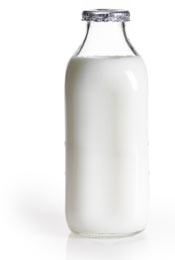UW study finds that larger dairy farms tend to have better milk quality
Wisconsin’s larger dairy operations tended to fare better than the state’s small farms in a UW–Madison study of milk quality, although all of the state’s farms — both large and small — produced milk that easily met federal food safety guidelines.

“I wanted to test this belief that I’ve heard a lot — that little farms are better,” says Steve Ingham, who led the study while working as a UW–Madison food science professor. Ingham is now the food safety division administrator at the Wisconsin Department of Agriculture, Trade and Consumer Protection.
“The take-home message is that when you group farms according to size the way we did, small doesn’t appear to be better in terms of milk quality,” Ingham says.
The study, published in the August 2011 issue of the Journal of Dairy Science, considered milk-quality data from 14,591 dairy operations around Wisconsin, of which 12,866 were classified as small farms (fewer than 118 cows); 1,565 as large farms (119-713 cattle); and 160 as confined-animal feeding operations (or CAFOs, with more than 714 cattle). The team used two common metrics of milk quality: reported bulk tank standard plate count (SPC) and somatic cell count (SCC), which together are also seen as good indicators of farm sanitation and animal-handling practices.
Across the board, CAFOs reported the lowest — and best — mean milk-quality scores for both SPC and SCC. Mean SPC (reported in colony-forming units per milliliter or cfu/mL) was found to be 35,000 cfu/mL for the CAFO group; 36,300 for large farms; and 58,700 for small farms. Mean SCC (in cells per milliliter or cells/mL) was found to be 240,000 cells/mL for the CAFO group; 273,000 for large farms; and 369,000 for small farms.
In all cases, mean SPC and SCC scores were far below the grade A maximum values, easily meeting the federal standards for milk intended to be pasteurized and sold for fluid consumption.
“The CAFO category had the lowest counts. It could be that they have more money to spend on good equipment. It could be that they have the ability to cull out cows with mastitis more quickly,” says Ingham, who is aware that some groups may take issue with the farm-size categories he created or the milk-quality measures he chose to use.
“Overall, I feel the numbers speak for themselves,” he says. “They give a good snapshot of the industry right now.”




